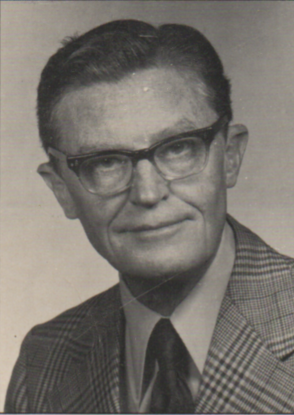"…a distinctive flag which will say to the future: I Stand for
Canada!"
L.B. Pearson
Ottawa: Liberal Federation of Canada, [1964]
I saw Lester Pearson once. This was in front of the Parliament Buildings on the sunny Saturday the country celebrated its centenary. Look carefully and you'll find me there in the crowd, along with my mum, my dad and Prince Philip. His wife has just taken a knife to that great big birthday cake. Balloons!
Pearson is the first prime minister I remember, though I don't remember much. The man stepped down when I was in kindergarten and died when I was eight. He wasn't prime minister for five years – and never enjoyed a majority government – yet managed to usher in the Canadian Pension Plan, universal health care and, of course, the flag. This address, delivered fifty years ago today, might be seen as the official beginning of the great debate surrounding that last struggle, but in truth the bickering stretched back into the nineteenth century. The great Sanford Fleming proposed this:
 |
| The Week, 31 May 1895 |
Pearson would've argued against Fleming's flag for the very same reason he argued against the string of red ensigns, affixed with various coats of arms and stylistic elements, that had at one time or another stood as an unofficial Canadian flag:
The red ensign has served Canada honourably and well since it was designated for such service by order in council; but those who are in favour of retaining it and making it permanent and official by parliamentary action must surely realize that basically – this is certainly no disrespect to the red ensign – it is the flag of the British merchant marine and it is similar, except for a different coat of arms, to the flags of certain British colonies.
Pearson went so far as to propose that his own preferred design be accepted by Parliament:
The speech is both cautious and calculated; history weighs heavily. Claude Ryan was sold, as was Charles Lynch. Scott Young – Neil's dad – predicted success in words reproduced at the back of this booklet:
Of course, John Diefenbaker would have none of it. Since 1926, he'd been railing against changing the ever-changing red ensign. In 1964, as Leader of Her Majesty's Loyal Opposition, he walked from farmhouse to outhouse, removed the stained wooden seat, and lowered himself into the pit with the insinuation that those who supported Pearson were being bought through bribery. That July, still waist-deep in excrement, he soiled himself thoroughly by asking why the government insisted that Christian crosses be removed from the flag.
His followers' filibustered. So dull, dull, very dull were their words that in September 1964 Pearson agreed to convene a fourteen-member Flag Committee composed of members from all four parties in the House of Commons. The flag we know is their doing. Their work inspired this wonderful Rex Woods' cover for the 8 July 1964 edition of Maclean's:
Growing up I never heard so much as a word against the flag. I took pride, cringing only once: in 1998, when Reform Party clowns hooted, hollered and honked about Parliament Hill for the right to display miniatures made in China on House of Commons desktops.
Today, members and defenders of the unholy party Reform spawned rank amongst the most vocal haters of that very same flag.
Mark Steyn dismisses our flag as a propaganda tool. Kathy Shaidle looks at the centuries-old national symbol worn by my grandfather during the Great War and sees "a dead leaf – basically tree dandruff".
Well, the 1963 Liberal platform did call for a new flag, as did those of the New Democrats and the Social Credit Party. Two-thirds of voters cast ballots in their favour. The flag flown today was supported by members of all four parties – Conservatives included – then sitting in the House of Commons.
Ah, but bastards will bastardize, trying to convince that the flag was forced upon the country. Whether it was
rammed or
shoved doesn't matter, the thing to take home is that it's in our throats and it's about time we cough it up. Visit the Sun News Network website – they'll appreciate the traffic – and descend into an alternate world every bit as imaginative as that of
The Man in the High Castle.
My favourite story is the one about a "flag that over 90% of Canadians wanted". Apparently, it was "designed by a young girl from Quebec – it had Three [
sic] green maple leaves in the centre and sea blue borders."
Like most oft-told tales, it improves with each telling.
My favourite version appeared on the site last December:
Ity [sic] was a school child [sic] a young girl from Quebec and her flag had three green real maple leaves and sea blue borders which was truly representative of our country and the most popular with the people. But the sneaky liberals [sic] under Pearson declared this was not a decision that required the full parliament [sic] and a few liberal [sic] MPs stayed behind on a Friday afternoon when parliament [sic] had supposed [sic] shut for Christmas and marked our country liberal [sic] red!"
Over to you, Ezra. You're sure to come up with something even more fanciful.
Object and access: A twelve-page booklet with paper covers. My copy, salvaged sixteen years ago from the bin of a Toronto Goodwill, appears to have been distributed by Joseph Macaluso, Member of Parliament for Hamilton West (1963-68). A barrister, the late Mr Macaluso served as one of the fourteen members of the Flag Committee.
Just where this booklet might be found is difficult to determine; ephemera such as this isn't often recorded in library catalogues.Only two copies are listed on WorldCat, both at the University of Toronto. I can find no copies for sale online.
























